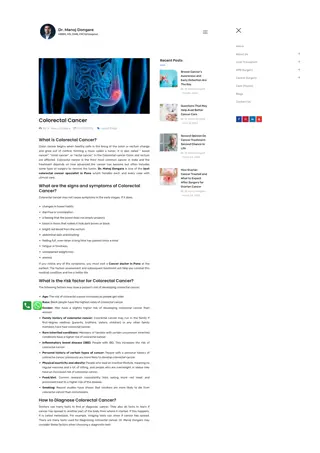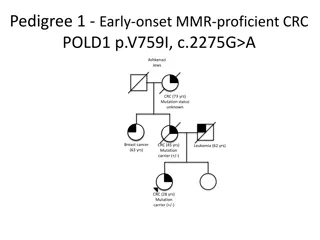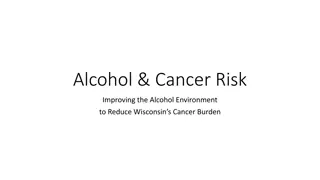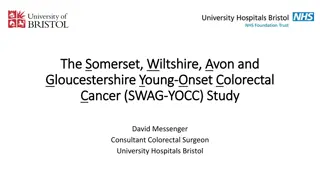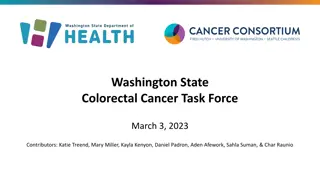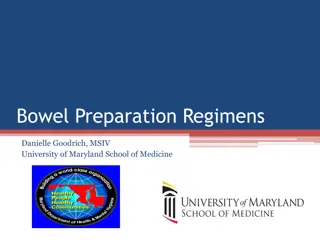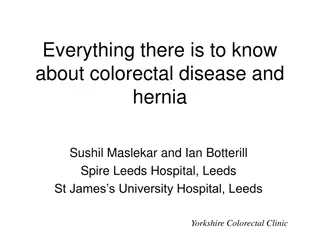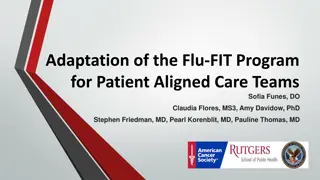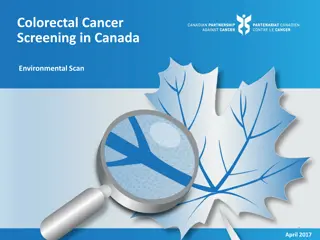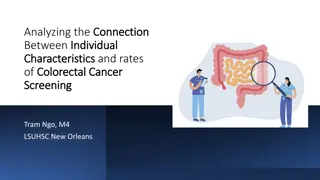Cathelicidin LL-37 in Colorectal Cancer Therapy
Colorectal cancer poses a significant health burden, with increasing incidence in younger individuals. This study explores the role of cathelicidin LL-37 and short-chain fatty acids in colorectal cancer therapy. Results indicate high LL-37 expression in cancer tissues, suggesting a potential therapeutic target. Understanding the mechanism of action of LL-37 and its derivatives may hold promise for future anticancer strategies.
Download Presentation

Please find below an Image/Link to download the presentation.
The content on the website is provided AS IS for your information and personal use only. It may not be sold, licensed, or shared on other websites without obtaining consent from the author.If you encounter any issues during the download, it is possible that the publisher has removed the file from their server.
You are allowed to download the files provided on this website for personal or commercial use, subject to the condition that they are used lawfully. All files are the property of their respective owners.
The content on the website is provided AS IS for your information and personal use only. It may not be sold, licensed, or shared on other websites without obtaining consent from the author.
E N D
Presentation Transcript
Cathelicidin LL-37 and its derivatives in therapy of colorectal cancer PhD candidate: Jakub W odarczyk Supervisor: Prof. dr hab. n. med. Jakub Fichna
Presentation outline Introduction Colorectal cancer Cathelicidin LL-37 Short chain fatty acids Aim of study Results Conclusions Achievements
Colorectal cancer Lifetime probability Female: 1 in 25 Male: 1 in 23 Increasing rate of incidence in individuals younger than 55 years old 5-year survival rate - 64% 14% for distant-stage disease 91% for localized disease Only 1 in 3 new cases is localized
Cathelicidin LL-37 Expressed in almost all tissues Maintains the integrity of the intestinal membrane Participates in inflammation and carcinogenesis LL-37 Regulates apoptosis and stimulates tissue regeneration Influences migration and proliferation of cells of the immune system
Short chain fatty acids Pleiotropic effects Suggested to have beneficial functions in patients with colorectal cancer
Aim of the study To specify the mechanism of action of LL-37 in the tissue of normal colorectal epithelium and colorectal cancer, and its dependency on vitamin D. To understand the mechanism of action of the antimicrobial peptide LL37 and to try to use its derivatives as a new, potential anticancer therapy.
Results 25 patients underwent colorectal resection due to CRC 25 samples from cancer tissue 25 samples from healthy intestinal mucosa from surgical margins mRNA LL-37 expression present in 100% of samples
T stage Grade relative LL-37 mRNA expression relative LL-37 mRNA expression 200 200 150 150 100 100 50 0 50 T1 T2 T3 T4 0 1 2 3 Results relative LL-37 mRNA expression relative LL-37 mRNA expression AJCC stage 200 200 relative LL-37 mRNA expression 200 150 150 150 100 100 100 50 50 50 0 0 N0 N1/2 0 CRC Healthy margin I II III 4-fold increase of LL-37 expression level compared with healthy intestinal mucosa Expression of LL-37 was significantly higher in stage III(AJCC), when compared to stage I. In patients with nodal metastases a 3.5-fold increase in LL-37 expression in cancer tissue
Results Molecular analysis of potential receptors involved in cathelicidin LL-37 mechanism pathways revealed: significantly reduced expression of TLR3 in the tumor tissue compared to tissue from the healthy margin, significantly increased expression of FPR-2 was observed in the tumor tissue compared to tissue from the healthy margin, no differences were observed in the expression of vitamin D receptor, MgrX, TLR 4 and CxCr2.
Results in vivo and in vitro studies Synthesis of compounds (KR-12 peptide and its derivatives modified with short-chain fatty acids): acetic acid, propionic acid, butyric acid.
Results in vitro and in vivo studies Assessment of the influence of tested compounds on viability of colorectal cancer and normal colon epithelium cell lines. KR12 - CCD 841 CoN KR12 - HT-29 Propionate derivative of KR12 CDC 841 CoN Propionate derivative of KR12 HT-29 75,8% vs 38,9% 150 150 120,3% vs 66,9% 100,26% vs 52,3% 69,9% vs 28,8% 200 150 100 100 % viability % viability 150 100 % viability % viability 100 50 50 50 50 0 0 0 0 Control 300 uM 250 uM 200 uM 150 uM 100 uM Control 300 uM 250 uM 200 uM 150 uM 100 uM Control 300 uM 250 uM 200 uM 150 uM 100 uM Control 300 uM 250 uM 200 uM 150 uM 100 uM
Results in vivo and in vitro studies Evaluation of the action of selected compounds in the mouse model of colorectal cancer.
Results in vivo and in vitro studies Molecular analysis of the material obtained from the animal model.
Conclusions KR-12 and KR-12 modified with propionic acid most significantly decreased the viability of cancer cells, while at the same time they were not cytotoxic to normal cells. In a mouse model of AOM/DSS-induced colorectal cancer, the beneficial effect of the tested peptides was expressed by: smaller macroscopic tumor lesions, smaller number of tumors, decrease in the analyzed pro-inflammatory cytokines. In human material, cathelicidin LL-37 expression is significantly elevated in colorectal cancer tissues compared to healthy intestinal epithelium. Potential receptors involved in the cathelicidin mechanism are TLR3 and FPR-2.
Achievements During my 4-year PhD program at International Doctoral School: Author or co-author of 29 publications Kosciuszko Foundation Scholarship awardee 4-months internship at Johns Hopkins University Co-author of a patent submitted in USA 4 international and 5 national conferences presentations Impact factor gathered during PhD program -> 109.377 151.423 including supplements




